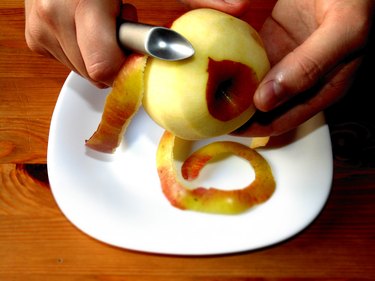
Some people just don't like the skin, while others send apple peels down the drain due to potential pesticide residue or wax. But you'll lose some significant nutrients if you don't eat the peel. About one-third of the apple's total fiber is lost if you toss the peel in the trash. You also eliminate all of the folate of the apple, and most of its vitamin E and vitamin K.
Fiber Found in the Peel
Video of the Day
You'll get both types of fiber -- soluble and insoluble -- from eating the apple peel, but about 77 percent of the total amount is insoluble. Insoluble fiber prevents constipation by binding with water and pushing digestive waste through the large intestine. Soluble fiber becomes gelatinous when it mixes with water in your digestive tract. It makes you feel full, slows down the absorption of nutrients, and prevents spikes in blood sugar. Soluble fiber also helps lower your levels of cholesterol. The peel from a medium apple contains 1.3 grams of total fiber.
Video of the Day
Nutrients and Antioxidant Flavonoids
The peel contains about 72 percent of the apple's antioxidant vitamin E and bone-building vitamin K. The skin also holds nearly half the total iron and all of the apple's folate. Apples produce antioxidants called flavonoids, which neutralize unstable molecules called free radicals before they damage healthy cells. Flavonoids may also prevent cardiovascular disease and inhibit the growth of cancer cells, according to the Linus Pauling Institute. The peel contains about 27.5 percent of the flavonoids found in a whole apple.
Concerns About Pesticides
Apple growers use a variety of pesticides, which causes concern about consuming pesticides that remain on the skin. The U.S. Food and Drug Administration inspects produce before it's shipped and at the market to ensure that pesticide residues are at or below safe levels. Washing the fruit removes most, but not necessarily all, of any remaining pesticides. If you're concerned about the amount you may consume from apple peels, buy apples that are certified organic, which means they were grown without man-made pesticides.
Wax on the Peel
Apples produce a natural wax coating that appears powdery on the peel. This natural wax protects the apple from absorbing water, while holding in its natural juice. The wax also contains a beneficial substance called ursolic acid, which stimulated muscle growth and weight loss in laboratory mice, according to an article in the June 2012 issue of "PLoS One." After harvesting, a small amount of additional wax is sometimes applied to prolong storage time. The wax is safe to eat, but remnants of pesticides may be trapped underneath it, so wash the apple to remove contaminants from the peel.
Proper Cleaning
Do not wash apples in soap because detergents can be absorbed into the peel. You also shouldn't wash apples in a sink or bowl of water because contaminants can spread through the water. You'll remove most of the wax and residue by rinsing the apple under cool water and drying it with a clean towel or paper towel. If needed, rub it gently with a soft cloth or vegetable brush to scrub away the wax.
- Jackson GI: Fruit Fiber Content
- University of Illinois at Chicago: Getting Enough Fiber in Your Diet Does not Have to be Like This
- Linus Pauling Institute: Flavonoids
- USDA Agricultural Research Service: USDA Database for the Flavonoid Content of Selected Foods
- Washington Apples: Pesticides
- Washington State University: Natural Waxes on Fruits
- PLoS One: Ursolic Acid Increases Skeletal Muscle and Brown Fat and Decreases Diet-Induced Obesity, Glucose Intolerance and Fatty Liver Disease
- Utah State University Cooperative Extension: Apples: Food Sense Guide to Eating Fresh Fruits and Vegetables
- USDA National Nutrient Database: Apples, Raw, With Skin
- USDA National Nutrient Database: Apples, Raw, Without Skin